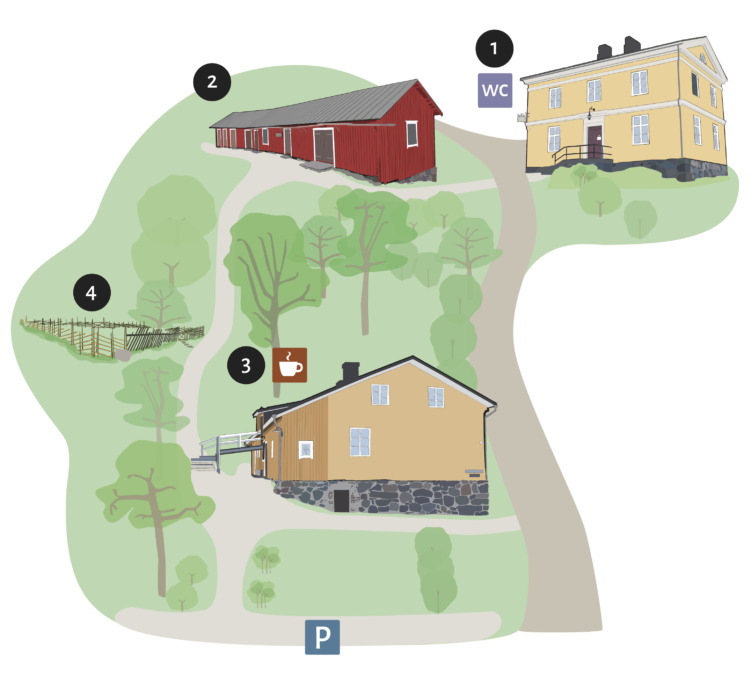The Museum area Hammarbacken
The Fiskars Museum is located on Hammarbacken in the Fiskars Upper Ironworks. Hammarbacken (“Hammer Hill”) received its name from an industrial trip hammer of iron that was located on the upper course of the Fiskars River since the 17th century. The Upper Ironworks was the early hub of Fiskars’ heavy industry, as it also housed a engineering workshop, a foundry, a rolling mill and a plow workshop.

1. The Main Building of the Museum – Old office
In the Main Building of the Museum you find our Main exhibition, ticket sale and Museum shop.
The building was constructed in the mid-19th century as an office for the engineering workshop and as living quarters for office workers. The architect of the building is unknown because the original drawings of the building are lost. In the 20th century, several working people families lived in the house. The building became a museum in 1949 on the initiative of office worker Laura Holmström and midwife Gerda Gers. In connection with renovation work undertaken in 2014, old layers of paint and wallpaper were found, which were used as inspiration for the selection of new surface materials. The walls were painted with a mild linseed oil paint, hand-pigmented in different shades. The windows were renovated using traditional methods. The Julin Room upstairs was reconstructed with purple stencil paint on the walls and the original wooden floor was uncovered. Old layers of paint and wallpaper are still preserved under the new surfaces. All rooms have old layers of paint and wallpaper, so-called colored staircases.
Read more about the Basic exhibition
2. Outhouse and Bakery
Firewood and garden tools were stored in the red outhouse opposite the old office. The building also houses one of the old bakeries and mangle houses of the Ironworks, which was shared by working families. During the summer, the aroma of freshly baked bread hovers over the baking tray. At the same time, you may see freshly washed linen towels hanging on a clothesline. In the outhouse and bakery we offer a variety of museum lessons, for example Ironworks Villager’s Activities, Time Travels and Workshops for groups. Beside the bakery you find the foundry were different metal workshops are arranged and the Upper Ironworks exhibition.
Read more about Ironworks Villagers’ Activities
3. Slaggbyggnaden
In 1842, the building was turned into a canteen for workers of the Upper Ironworks. Due to a general housing shortage, the building was later used as a home for several working families and single people. In 1970, residents abandoned the house and it lay deserted until 1983 when the Museum took over the building and renovated it into exhibition space. Upstairs you can see, among other things, the apartment of the widow and the cabin of the bachelor. Today, the Museum Office and Café Hammarbacken are located on the ground floor of the building. In the cosy café you can enjoy freshly baked buns with a cup of coffee.
4. The Hammarbacken Museum Garden
The museum garden is located between the outhouse and the Slaggbyggnaden building. During the 20th century, the museum buildings were used entirely or partially as residential houses for the ironworks’ workers, which is why the slope above was actively cultivated with root vegetables and useful plants. Families in the area also kept livestock, such as chickens. When the houses were vacated in the 1970s, the garden gradually became overgrown.
In recent years, the area has been developed into a museum garden, where, starting in the summer of 2025, visitors will be able to learn about traditional circular household practices, heritage plants, gardening as a hobby, and receive tips on sustainable living and ways to support biodiversity.
Things to know Before the Visit
We welcome everyone to the museum regardless of gender, age, ethnicity, religion, sexual orientation or disability. We regret that the Museum area is not very accessible for disabled visitors at the moment, though we hope to change this is the near future. Contact us in advance and please let our staff know of your concerns. Our staff will be happy to assist you to ensure you the best possible museum experience.